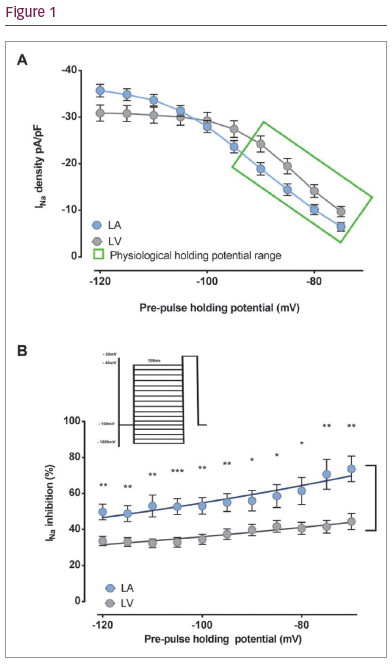Introduction: The cardiac voltage-gated sodium current (INa) is a target of several anti-arrhythmic drugs for treatment of atrial fibrillation (AF). As current drugs do not specifically target atrial INa, there is increasing interest in development of atrial-specific ion channel blockers. Characterisation of INa biophysical properties in atria and ventricles is, therefore, crucial for development of selective antiarrhythmic drugs for treatment of atrial fibrillation.
Aim: To compare biophysical and pharmacological properties of INa between mouse left atrial and ventricular cardiomyocytes.
Methods: Na+ channel currents were measured using whole-cell voltage clamp in left atrial and ventricular cardiomyocytes. Expression of Nav1.5 proteins and Navβ-subunits was measured by Western blotting in left atrial and left ventricular tissue of wild-type 129/sv mice (15–20 weeks) and in human heart tissue from patients with heart failure or from (unsuitable) donor hearts. Protein levels were normalised against GAPDH.
Results: At physiological holding potentials, peak INa was lower in atrial compared to ventricular cardiomyocytes (Figure 1A). From a holding potential of –75 mV peak current density was 6.46 ± 0.88 pA/pF (n=40/13 cells/mice) in the LA and 9.73 ± 1.01 pA/pF (n=28/13 cells/mice) in the LV (*p<0.05). Furthermore, V50 for both INa activation and inactivation was significantly more negative in atrial cardiomyocytes.
Flecainide showed increased efficacy in the blockade of INa in the atria when compared to the ventricles at all holding voltages tested (Figure 1B). From a holding potential of –70 mV flecainide blocked INa by 75.9 ± 6.8 and 44.4 ± 4.5 % in the atria and ventricle respectively (n = 12–14 cells/>3 mice, p<0.01).
Expression of β2 and β4 subunits was lower in human and mouse atrial tissue when compared to ventricle (LA = 0.22 ± 0.03; LV = 0.41 ± 0.05; *p<0.05; n = 6) and (LA = 0.09 ± 0.01; LV = 0.21 ± 0.01; ****p<0.0001; n = 6). In diseased human atria, expression of β2 was increased when compared to healthy atria (0.39 ± 0.03 versus 0.22 ± 003, **p<0.01; n=4)
Conclusions: At physiological holding potentials INa is reduced and more sensitive to flecainide block in healthy LA cells when compared to the LV. Alterations in biophysical properties of INa in atrial myocytes may be attributable to reduced expression of the Nav1.5 β2 and β4 subunits. In human failing hearts, increased expression of the Nav1.5 β2 subunit may alter INa and responses to flecainide. The interactions between Nav1.5 and its β subunits require further investigation and may provide novel targets for antiarrhythmic drug therapy.








